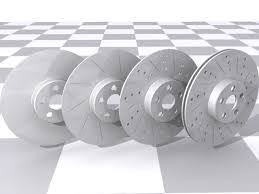Essentially there are 4 types of brake disc:
Normal
Drilled
Grooved / Vented
Pimpled
You can also get a hybrid of usually two types, in which case, combine the pros and cons of both varieties.
Normal brake discs:Your standard, flat faced brake discs. Flat faced brake discs have the most surface area touching the brake pad when brakes are applied, giving good initial braking power. The problem with normal brake discs is that as they heat up through everyday use, they can get build up of gas between the pads and the disc, causing “Brake fade” and or “Pad Glazing”
Drilled brake discs: The face of these discs are drilled all the way through to increase surface area and so can cool quicker and also help a little bit in releasing the gas build up between the pads and brake discs, reducing the chance of “Brake fade” The problem with drilled brake discs is that the holes tend to have a tendency to crack and or collect debris.
Grooved brake discs: The face of these brake discs have diagonal lines cut into them, there are two reasons for this. Firstly they allow the venting of brake pad gasses thus eliminating brake fade. They also eject brake pad dust to stop glazing of the pad. This keeps the pad face fresh allowing better braking. The problem is that grooved discs have a tendency to be louder when the brakes are applied due to the scrubbing of the pads. Discs with grooves should be installed a certain way round. As the disc rotates in its normal direction, the groove should be spinning outwards. This allows the brake dust to be ejected away from the hub. Putting them on rotating the wrong way can allow the brake dust to accumulate in the centre of the hub.
Dimpled brake discs: The face of these brake discs have dimples punched into them. The dimples help clear debris and dust from the pad but are mostly used for the look and to reduce weight.


this is one fantastic piece of information, thanks
Hi all,
Which discs you suggest for my freelander 2 2011, actually I found only normal discs from MINTEX group. What about MINTEX DISCS quality?
Best regards
Hi Djoubir,
We tend to use Ferodo, OEM or genuine Land Rover. However we have never had any issues with the Mintex brake parts when we have used them.
All the best,
Sue